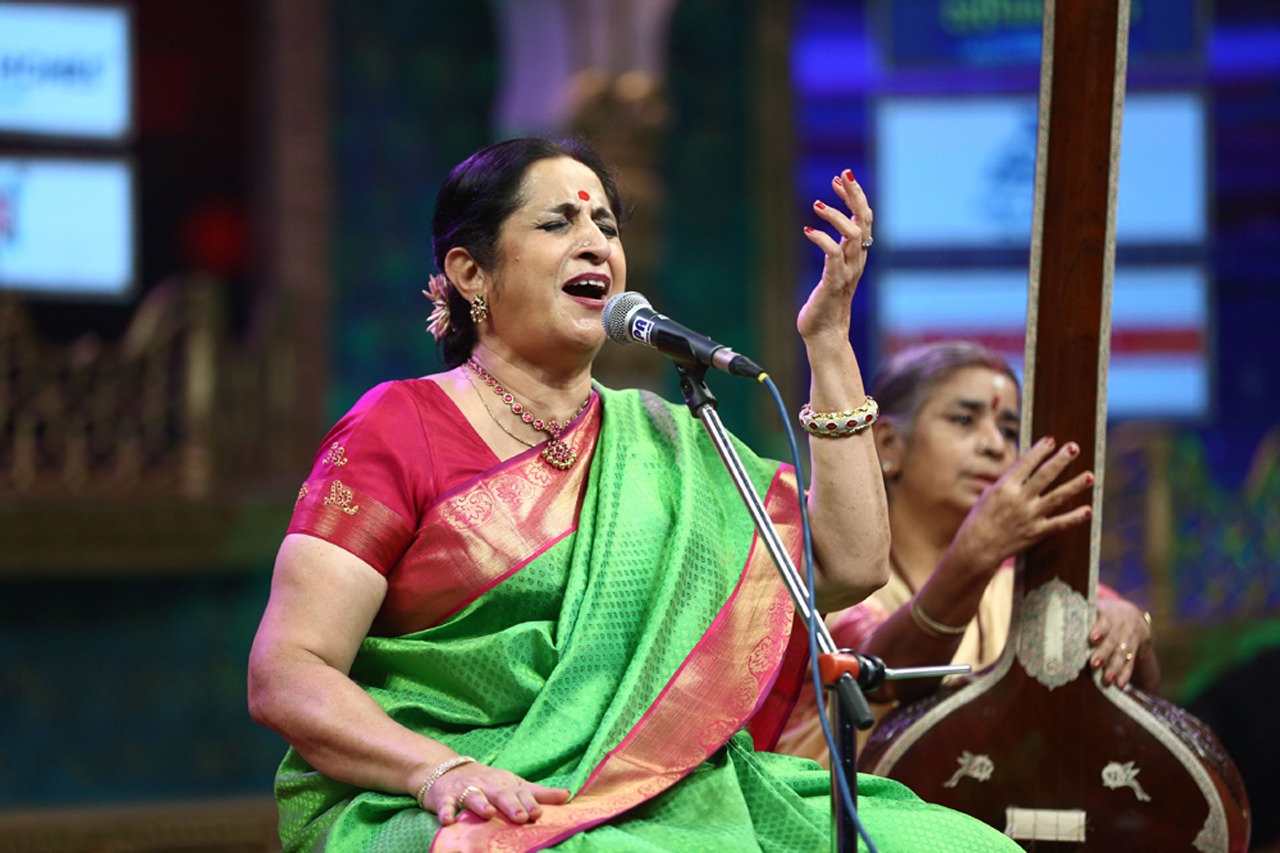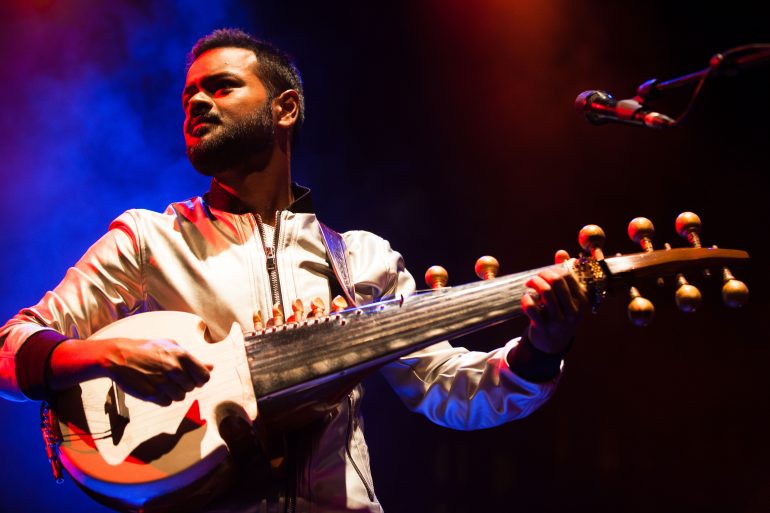On March 15th, Bagri Foundation with Soumik Datta Arts present Back to the Blues, a one-off collaboration exploring connections between South Indian music, North Indian music, and contemporary jazz. Aruna Sairam’s voice and Soumik Datta’s sarod (19-string fretless lute) will be accompanied by a host of outstanding musicians from diverse traditions: Al MacSween on jazz piano, Cormac Byrne on bodhrán Irish frame drum, and Pirashanna Thevarajah on Carnatic percussion (mridangam, morsing, and kanjira tambourine).
George Howlett caught up with both the lead artists in advance of the concert, to discuss cross-cultural improvisation, Indian music’s modern diaspora, and what their gurus would make of the blues.
Aruna Sairam and Soumik Datta are two of India’s most relentless musical collaborators. But tackling the blues is new ground. Back to the Blues is a real one-off, with Aruna’s voice and Soumik’s 19-string sarod being accompanied by jazz piano and a feast of Indian and Irish percussion. St. John’s Smith Square, a former baroque church, will provide a resonant space for this fresh branch of the growing Indo-Western collaboration tree.
Aruna Sairam is at the helm of South India’s Carnatic tradition. She is an exponent of ‘pure’ Carnatic singing but also looks outwards, with collaborations ranging from jazz and Sufi to Gregorian chant and film scores. She sings in 12 different languages, and vice-chairs the Sangeet Natak Akademi, India’s premiere national music and dance institution.
Soumik Datta is a sarod player from the younger generation. He performs North Indian Hindustani music alongside working with collaborators across the world: Austria, Japan, Korea, Congo, and beyond. He has roots in the West too, having studied in Kolkata during his holidays from boarding school at Harrow, before heading to Trinity. Today he plays everything from classical ragas to drum & bass, and preserves unrecorded Indian folk music through the Tuning 2 You project. Rumour has it he once turned down the chance to take his sarod on tour with Beyoncé.
Aruna and Soumik are enthusiastic, overflowing with thoughts on their musical cultures as evolving traditions. They’ve been bonding over B.B. King and see similarity between Indian classical music and the blues: improvised aural traditions infused with folk melodies, driving rhythms, microtones, and a hypnotic spirituality. But the styles are worlds apart too: blues is proudly loose, whereas Indian classical is precise and mathematical, requiring years of intense discipline to master. So how will they fit together?
Soumik’s been working on the music for the last couple of months. In conversation he discusses how the blues and Hindustani classical are awash with long sustained melodies, and how he can rearticulate the vocabulary of blues guitar by sliding around the sarod’s metal fretboard. He sees pentatonic scales as a universal bridge, pointing out that they also underpin Chinese and Japanese classical music. Aruna is relishing the chance to fuse disparate folk tunes, and find shared spaces for “deep, melancholic melodic exploration”.
But what can the styles learn from their differences? Soumik dislikes the term fusion (perhaps a hallmark of successful fusioneers) however feels that each style has distinct approaches to draw from: “Hindustani music is controlled and detailed, so in a way you’re spiralling inwards as you elaborate a rāga, towards the centre. But the long, repetitive, open structures of the blues allow you to spiral outwards”.
Aruna agrees, speaking about the depth and detail afforded by Carnatic’s precise rhythms and structures, and what they can bring to the blues. She points out that bluesy influences are already there in Carnatic tukda (‘little pieces’), but admits that Carnatic musicians “could still loosen up a bit”.
She acknowledges the tension between preserving traditional forms and effectively communicating them to outsiders who lack reference points. However she assures me that Western ears will appreciate unfamiliar Carnatic scales. She recounts “a moment of revelation” when she hesitated before singing Raag Todi to Western students, for fear that its irregular shape would prove too much for the uninitiated. But the performance entranced them, and afterwards she reflected on their responses: “This way it’s not just you that we hear – we hear your guru, and your guru’s guru…”. (This is fortunate, as there are plenty of flavours to draw from, with 72 distinct scales derived from Carnatic’s clock-like Melakarta wheel.)
Indo-jazz fusion can also draw from its own rich past. Soumik explains that “John McLaughlin is an inspiration, and Shakti is a big influence on my life”. His promise of energetic percussion at this concert may owe a debt to Shakti’s busy drum duets – expect deep mridangam, kanjira, and bodhran tones to echo through the church, driving the low end of grooves in the absence of melodic bass instruments.
Indian instruments have rich, full timbres, awash with drones and resonating strings. But this presents a challenge for ensemble settings, where they can crowd out thinner sounds. Soumik seeks to balance this by “pairing up” the instruments, such as having the sarod and mridangam alternate against bodhran and piano, question-and-answer style.
These alternations are no surprise given Soumik’s ability to mentally compartmentalise his music, allowing him to play alongside electronics and string quartets without diluting his traditional Hindustani performance. But classical forms always underpin his sound: “Hindustani music is an infinite source, and the classical foundations must be constantly reinforced”.
Back to the Blues, in keeping with the traditions it draws from, will be largely improvised. Aruna discusses how strange it is that some Western students learn music without improvisation – you wouldn’t learn language without spontaneous conversation, or poetry by merely copying out the work of other poets. She recounts a frustrating experience at a classical conservatoire in Germany, where few students turned up to her masterclasses. I mention that classical students were probably intimidated by her non-written, improvised approach, and she reassured me that they came around in the end.
It’s often assumed that older Indian gurus were dismissive of their protégés’ fusions, but this isn’t always the case. After all, India has been a musical fusion ground for millennia (you could even say it was ‘Westernised’ centuries ago by the invading Mughal Empire). Soumik and I share condolences for the recent passing of his guru, Pandit Buddhadev Das Gupta, who he stayed in contact with until the end: “He found intellectual interest in my fusion work. But he was a purist in the rāga world, and his soul is with the traditions”.

Aruna’s guru, the stern veenai and vocalist T. ‘Brindamma’ Brinda, taught with few words – Carnatic is learned by ear. Aruna only received small hints when learning a new rāga, and believes that “creativity is imbibed, not taught”. She empathises with pianist Bill Evans’ words to his brother: “No, I’m not going to give you the answer to your question. I don’t want to deny you the pleasure you’ll receive when you figure it out yourself”.
Aruna first learnt to sing by listening to her mother and is part of a long line of female musicians. The direct teaching lineage stretches back over 200 years, to the singers and dancers of the Tamil court. She highlights the psychological obstacles faced by women today (“you’re constantly told you’re not good enough…it can be more difficult to be in touch with your inner talents, as society expects women to nourish others first”), and encourages female musicians to collaborate and discuss their challenges.
Both are avid social media users and appreciate how technology is expanding their traditions. They’ve been sharing music via e-mail in advance of rehearsals, and Soumik has experimented with electric sarod and pedal boards in the past. Aruna is “grateful to the fans who have appreciated my music and uploaded it on YouTube”, and enthusiastic about how the internet can demystify Indian music (during the interview I get a brief Skype lesson on how to add the ‘blue note’ to a rāga without violating its form).
They’re positive about the overall health of their traditions. Aruna says it’s easier to build a career nowadays, with more sponsorship and collaboration, and Soumik describes the Hindustani scene as thriving (his Soumik Datta Arts charity supports young musicians). And Aruna sees how India’s vast global diaspora also adds depth: “Now we have students from America who first learn in California, then move to Tamil Nadu to further their studies”. She recommends me several younger singers (Sid Sriram, Abishek Raghuram, and Sandeep Narayanan).
Back to the Blues’ backing band are all outstanding musicians in their own right: Al MacSween on jazz piano, Cormac Byrne on bodhrán Irish frame drum and percussion, and Pirashanna Thevarajah on Carnatic percussion (mridangam, morsing, and kanjira tambourine). It must surely be the first time these instruments have been grouped together live, and the setting of an old baroque church will add further cultural dissonance. The concert promises something for all open ears – melodic conversations, fiery percussion duels, and familiar ideas set against fresh forms.
George Howlett
Back to the Blues with with Aruna Sairam & Soumik Datta | Tickets (£10-35)
Thu 15th Mar, 7:30pm | St John’s Smith Square, London, SW1P 3HA
Event and Ticket Info

